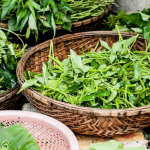We call it Green Goop and it’s what we smear on wounds, rashes, cold sores, and more. I’ve been making it for some years now, and it’s not vegan, it’s not pretty, and it’s not for sale. It is my down and dirty, cheap and functional herbalism for human survival. Creating it is a deeply sacred and reverent process, even when I swear a lot.
Also: anything I say is my own experience. I am not a doctor. Do not take my advice. Do your own research. Read books. Meet local herbalists. Make your own decisions. Comfrey is not recommended for internal use.
Growing the Ingredients
First you have to decide what kind of comfrey you want. The most basic comfrey can be grown by seed, but I’d recommend buying plants to make your life simpler. I always recommend Richter’s Herbs. Now if you have lots of space or intend to harvest the heck out of your comfrey, getting the plain old will be fine. However if you have a smaller garden space I would suggest getting Russian or Bocking-14 Comfrey. Common comfrey will spread from the roots. That means anywhere the roots reach, little comfrey plants will emerge and try and take over. Comfrey’s a lot like the Borg. It will assimilate. Russian Comfrey is not like that. It only gets bigger through clumping in a polite circle. It won’t send out little invaders into your more fragile gardens. I have both kinds. The Russian Comfrey has prettier flowers. I carefully placed the Common Comfrey next to the Tansy and the Elderberry so it has tough friends who can handle its pressure. I use comfrey to make fertilizer as well as herbal products, so it gets cut down a lot and just doesn’t have that much time to take over. I keep my comfrey busy.
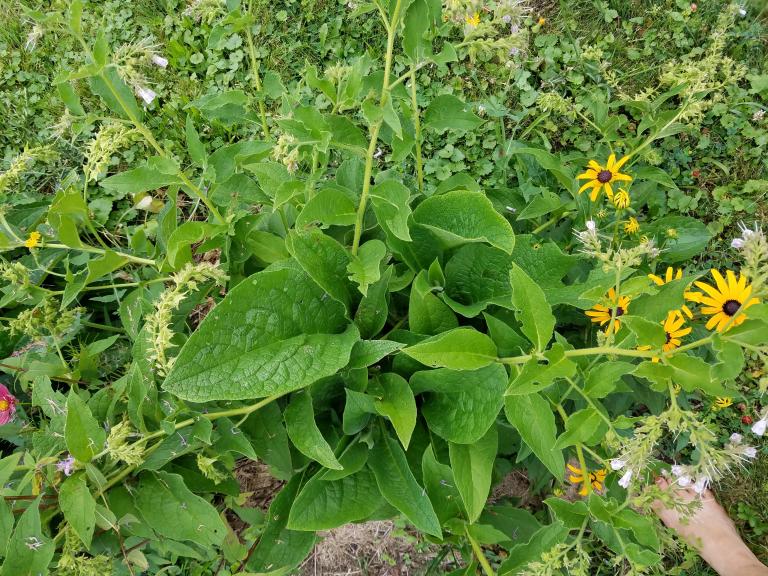
Next you have to learn to recognize plantain. I’m talking the weed, not the delicious starchy banana like food. Plantain weed is a low growing plant with two forms, broadleaf and lanceolate. Basically some of them have wide round leaves and some of them have long narrow leaves. All of them are low growing little circles of leaves that are often found in the edges of gravel driveways and in places where other plants dare not to tread. They are in a very special group of plants that can bust up hardpan and live in toxic soil. Don’t harvest those ones. Find the nice fat happy ones that will gladly grow to a foot across in your garden. One of the best ways to tell if a leaf is plantain is to look at the veins. Most leaves have one central vein with a bunch of veins that branch off to the sides. Plantain leaves have a bunch of veins running parallel to each other from the base to the tip of the leaf.
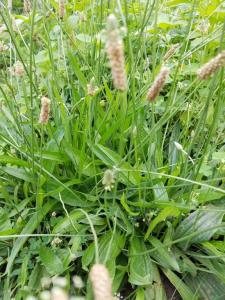
Harvest and Processing
Harvest the comfrey and the plantain in June, in the north. Look for the comfrey to flower and then harvest the flowering tops and leaves. Just pull the leaves off the plantain plant. If you leave the smaller leaves in the center, you can come back again and harvest later. Sing a song while you harvest to make the spirit of the land and the plants happy. Anything will work, though I like John Denver’s Garden Song. I’ve also been known to sing them Bohemian Rhapsody and they like that just as well.
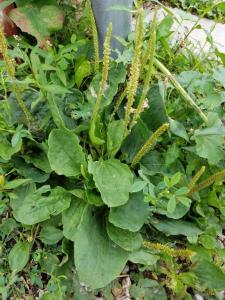
Here’s the recipe:
I recently shared this when asked to write it down by the Rev. Chelly. She’s an amazing priest and deathworker, check her work out here.
I use two pounds of lard, with a large pile of comfrey and a large pile of plantain. Do not wash the herbs. Chop them roughly and boil them in the oil, using as much of the leaves as you can cram in. let it sit for a day or two, then boil again. Do that 2-4 times until it’s nice and bright green in the fat. Boil it one more time and strain and pour into a quart mason jar. Let cool until lukewarm then add about a dram of essential oil, my favorites are geranium (for burns) and tea tree (for antibacterial) also for smell, because it smells like green lard. Mix and then pour into smaller jars with lids. Let cool. For external use only.
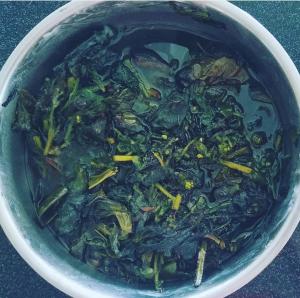
I don’t recommend using this salve on dirty wounds because it can cause healing to take place too fast and trap in dirt and infection. In that case I use chickweed tincture to draw out the dirt and promote healing, and once the wound is clean, then I use the salve on it.
I use lard because it’s an inexpensive saturated fat that I can get locally. Saturated fats sink deeper into the epidermal layer. I use a metal bowl to boil it in, so that I don’t lose the use of a good pot for an entire week. Good luck with your herbal experimentation, may the spirits of the land and healing be with you. Don’t forget to do your own research and trust your own experience!
If you use this info to start your own herbal practice, consider reciprocating and wandering over to my Patreon to sign up for all the extra posts about my odd little Addams Family life.

